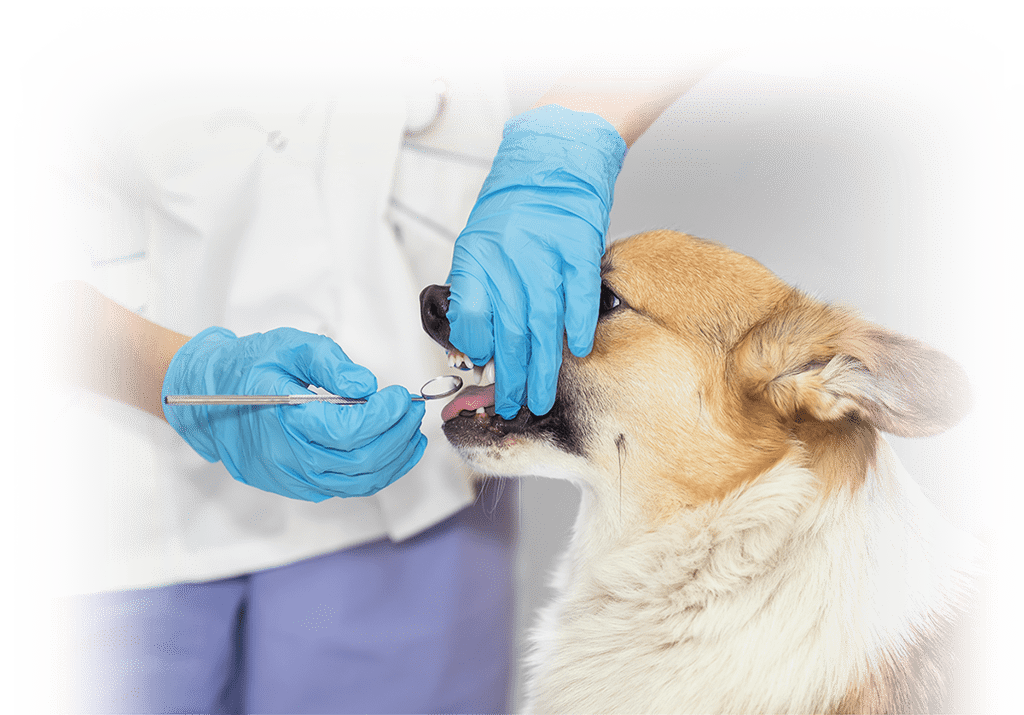Our Calming Techniques
Making sure your pet is comfortable and at ease is one of the keys to non-anesthetic teeth cleaning procedures.


Nice and Easy
Even dogs and cats that become anxious can be made to feel at ease with the proper relaxation techniques, allowing for a stress-free experience for your pet during their teeth cleaning. This calm state of mind is achieved through a series of steps that comfort your pet during its procedure.
For smaller dogs, the vet will begin by swaddling the dog to ease their tension and calm their nerves. The vet often will use a similar approach to relax cats.
Larger dogs may be calmed by using a neck pillow to make them feel comfortable and relaxed.
If needed, the vet will take a short break during the session to allow the pet to move and stretch for a moment before the last portion of the procedure is conducted.
Is your dog or cat feeling anxious?
While dogs and cats cannot verbally communicate with us, they often provide visual signals indicating how they feel. For instance, when a dog is feeling anxious a good indicator is the position of its tail If the dog’s tail is tucked in under its hind legs it is a signal that the dog is feeling uncomfortable.
Other signals may include:
- Frequent pacing
- Uncontrollable shaking
- Non-stop yawning
Please note, if your pet remains too anxious and cannot remain relatively still during the procedure, the veterinarian may decline to do the cleaning.

Calming techniques are used for relaxing your pet before and during a procedure.
Dogs come in a wide variety of shapes and sizes and the VanVets team utilizes several maneuvers when working with your pet to ensure they remain calm and comfortable while the vet can conduct the teeth cleaning efficiently and effectively without missing anything.
Medium-sized dogs usually lie on their back on a mat between the vets’ legs so the veterinarian can have easy access to the mouth area while maintaining control. The team monitors your pet at each step of the calming process to make sure the pet is comfortable and relaxed.
For smaller dogs, the vet may use a technique called “swaddling” where the dog is moved back and forth within the comfort of a soft blanket. This method generally induces relaxation in the dog and makes it easier for the vet to perform the cleaning. This can be done on our exam table or in our larger area off the table.
If necessary, a dog that has a medical condition may be laid on its side during the procedure. Another option is for the dog to sit directly in front of the veterinarian. Larger dogs are also generally seated directly in front of the veterinarian or standing facing the vet.
If it is an older or sick dog that can’t stand for very long, the vet may have the dog lie down and perform the procedure with the dog on a table or on a mat on the floor.
For cats, the goal is to utilize a form of swaddling where the cat’s paws are extended out in front of their body to reduce attempted clawing during the procedure. Cats remain on their back or in front but facing the opposite direction of the veterinarian to keep the front paws extended. The vet may allow for an extra break if it is an older cat so they do not become exhausted during the procedure.

Keep your pet on the path to healthy teeth and gums
Your pet care journey with VanVets includes a comprehensive medical record of your pet that will include your pet’s visit history notes neatly organized to ensure future appointments will be done with your pet’s history in consideration.
Help the veterinarian help your pet
Current vaccinations, any current or past medical conditions or issues, any medication allergies or previous reactions are examples of information that is extremely helpful for the veterinarian to better know your pet. We will requests some background information on your pet prior to your appointment so that we can provide the best possible care.
To better understand your pet, we ask that pet owners complete a medical history form before their pet’s appointment and evaluation process.



Save $50 now on our introductory Teeth Cleaning & Wellness Exam.
Limited time only, make an appointment today.

Call to schedule an appointment.
Mobile Veterinary Services
We provide convenient, affordable and hassle-free veterinary care services for cats and dogs in our state-of-the-art mobile veterinary clinic. Schedule a visit at one of many pet retail locations across the valley. For even more convenience, we can bring our mobile clinic to your home! OR we can use our Tesla Mobile Paw Transporter to take your pet to and from our mobile clinic. (Travel rates vary).
Dental Cleaning
VANVETS’ licensed veterinarian professionals and technicians, provide expert anesthesia-free dental prophylaxis (cleaning).
Microchipping
Vaccines
All dogs and cats need preventative medical care in the form of vaccines. We offer a wide variety of dog vaccines.

Travel Certificates
Are you planning a vacation trip and bringing your pet? For both international and domestic travel, you will need to obtain a Certificate of Veterinary Inspection (CVI).
Diagnostic Tests
VANVETS' diagnostic onboard lab hosts a wide array of diagnostic tools to quickly assess your pet’s health and determine what therapy, if any, is required.
Diagnostic Imaging
VANVETS uses state-of-the-art ultrasound equipment to examine and evaluate your pet's health.
